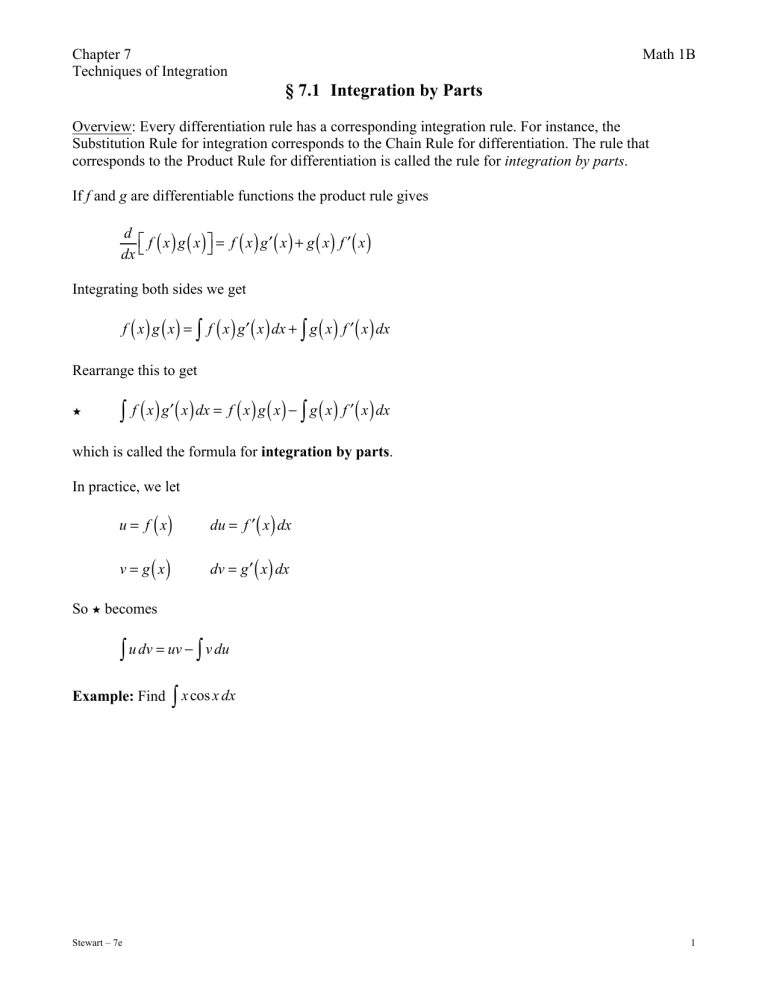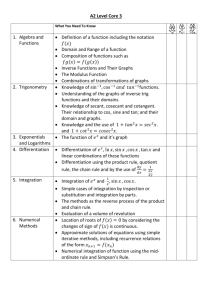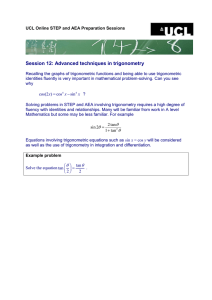§ 7.1 Integration by Parts
advertisement

Chapter 7 Techniques of Integration Math 1B § 7.1 Integration by Parts Overview: Every differentiation rule has a corresponding integration rule. For instance, the Substitution Rule for integration corresponds to the Chain Rule for differentiation. The rule that corresponds to the Product Rule for differentiation is called the rule for integration by parts. If f and g are differentiable functions the product rule gives d ⎡ f ( x ) g ( x ) ⎤⎦ = f ( x ) g ′ ( x ) + g ( x ) f ′ ( x ) dx ⎣ Integrating both sides we get f ( x ) g ( x ) = ∫ f ( x ) g ′ ( x ) dx + ∫ g ( x ) f ′ ( x ) dx Rearrange this to get ★ ∫ f ( x ) g ′ ( x ) dx = f ( x ) g ( x ) − ∫ g ( x ) f ′ ( x ) dx which is called the formula for integration by parts. In practice, we let u = f ( x) du = f ′ ( x ) dx v = g ( x) dv = g ′ ( x ) dx So ★ becomes ∫ u dv = uv − ∫ v du Example: Find Stewart – 7e ∫ x cos x dx 1 Example: Find ∫x e Example: Find ∫ ln (5x ) dx Stewart – 7e 2 −3x dx 2 Example: Find Stewart – 7e ∫e x cos x dx 3 Example: Find ∫ sin x dx We can evaluate definite integrals using integration by parts. 1 Example: Find ∫ sin −1 x dx 0 Stewart – 7e 4 9 Example: Find ∫ ln y y 4 dy If you’re not sure what to pick for u, refer to the following list: L: Logarithmic functions: ln x,log 3 x I: Inverse trigonometric functions: tan −1 3x,sin −1 A: Algebraic functions: x 2 − 8x + 2, x , T: E: For example: w 5 x−3 2x + 1 2 Trigonometric functions: cos6x,sec x Exponential functions: e−7 x ,4 x ∫ x ln3x dx ∫ x e dx ∫ tan 8x dx 2 Choose u = ln3x because logarithmic appears before algebraic 4 −2 x Choose u = x 4 because algebraic appears before exponential −1 Sometimes it doesn’t matter: Stewart – 7e ( ) Choose u = tan −1 8x because that is your only option ∫e x cos x dx 5



